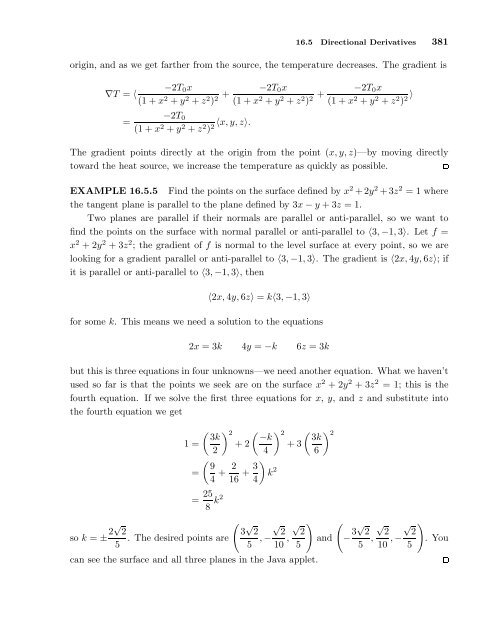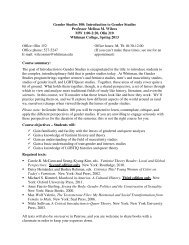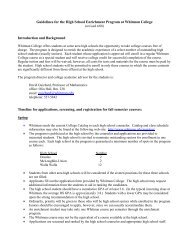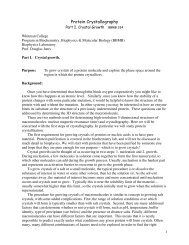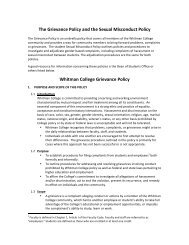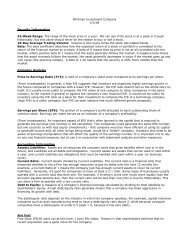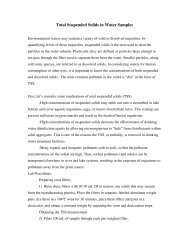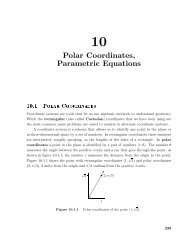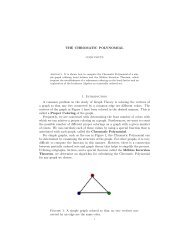380 <strong>Chapter</strong> <strong>16</strong> <strong>Partial</strong> <strong>Differentiation</strong>immediately provides us with some additional information. We know thatD u f = ∇f ·u = |∇f||u|cosθ = |∇f|cosθif u is a unit vector; θ is the angle between ∇f and u. This tells us immediately that thelargest value of D u f occurs when cosθ = 1, namely, when θ = 0, so ∇f is parallel to u.In other words, the gradient ∇f points in the direction of steepest ascent of the surface,and |∇f| is the slope in that direction. Likewise, the smallest value of D u f occurs whencosθ = −1, namely, when θ = π, so ∇f is anti-parallel to u. In other words, −∇f pointsin the direction of steepest descent of the surface, and −|∇f| is the slope in that direction.EXAMPLE <strong>16</strong>.5.3 Investigate the direction of steepest ascent and descent for z =x 2 +y 2 .The gradient is 〈2x,2y〉 = 2〈x,y〉; this is a vector parallel to the vector 〈x,y〉, so thedirection of steepest ascent is directly away from the origin, starting at the point (x,y).The direction of steepest descent is thus directly toward the origin from (x,y). Note thatat (0,0) the gradient vector is 〈0,0〉, which has no direction, and it is clear from the plotof this surface that there is a minimum point at the origin, and tangent vectors in alldirections are parallel to the x-y plane.If ∇f is perpendicular to u, D u f = |∇f|cos(π/2) = 0, since cos(π/2) = 0. This meansthat in either of the two directions perpendicular to ∇f, the slope of the surface is 0; thisimplies that a vector in either of these directions is tangent to the level curve at that point.Starting with ∇f = 〈f x ,f y 〉, it is easy to find a vector perpendicular to it: either 〈f y ,−f x 〉or 〈−f y ,f x 〉 will work.If f(x,y,z) is a function of three variables, all the calculations proceed in essentiallythe same way. The rate at which f changes in a particular direction is ∇f ·u, where now∇f = 〈f x ,f y ,f z 〉 and u = 〈u 1 ,u 2 ,u 3 〉 is a unit vector. Again ∇f points in the direction ofmaximum rate of increase, −∇f points in the direction of maximum rate of decrease, andany vector perpendicular to ∇f is tangent to the level surface f(x,y,z) = k at the pointin question. Of course there are no longer just two such vectors; the vectors perpendicularto ∇f describe the tangent plane to the level surface, or in other words ∇f is a normal tothe tangent plane.EXAMPLE <strong>16</strong>.5.4 Suppose the temperature at a point in space is given by T(x,y,z) =T 0 /(1+x 2 +y 2 +z 2 ); at the origin the temperature in Kelvin is T 0 > 0, and it decreases inevery direction from there. It might be, for example, that there is a source of heat at the
<strong>16</strong>.5 Directional Derivatives 381origin, and as we get farther from the source, the temperature decreases. The gradient is−2T 0 x∇T = 〈(1+x 2 +y 2 +z 2 ) 2 +=−2T 0(1+x 2 +y 2 +z 2 ) 2〈x,y,z〉.−2T 0 x(1+x 2 +y 2 +z 2 ) 2 +−2T 0 x(1+x 2 +y 2 +z 2 ) 2〉The gradient points directly at the origin from the point (x,y,z)—by moving directlytoward the heat source, we increase the temperature as quickly as possible.EXAMPLE <strong>16</strong>.5.5 Find the points on the surface defined by x 2 +2y 2 +3z 2 = 1 wherethe tangent plane is parallel to the plane defined by 3x−y +3z = 1.Two planes are parallel if their normals are parallel or anti-parallel, so we want tofind the points on the surface with normal parallel or anti-parallel to 〈3,−1,3〉. Let f =x 2 +2y 2 +3z 2 ; the gradient of f is normal to the level surface at every point, so we arelooking for a gradient parallel or anti-parallel to 〈3,−1,3〉. The gradient is 〈2x,4y,6z〉; ifit is parallel or anti-parallel to 〈3,−1,3〉, then〈2x,4y,6z〉 = k〈3,−1,3〉for some k. This means we need a solution to the equations2x = 3k 4y = −k 6z = 3kbut this is three equations in four unknowns—we need another equation. What we haven’tused so far is that the points we seek are on the surface x 2 + 2y 2 + 3z 2 = 1; this is thefourth equation. If we solve the first three equations for x, y, and z and substitute intothe fourth equation we get( ) 2 ( ) 2 ( 3k −k 3k1 = +2 +32 4 6( 9=4 + 2<strong>16</strong> + 3 )k 24= 258 k2(so k = ± 2√ 25 . The desired points are 3 √ √ √ ) (2 2 25 ,− 10 , and − 3√ √ √ )2 2 25 5 , 10 ,− . You5can see the surface and all three planes in the Java applet.) 2


